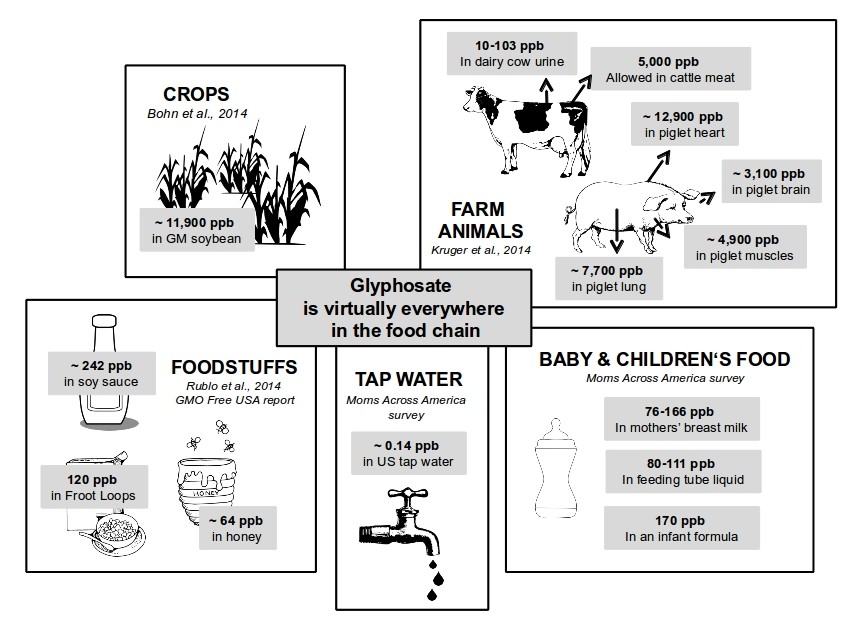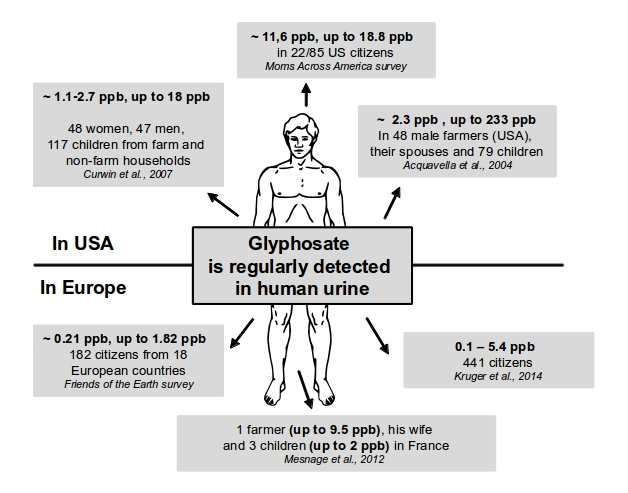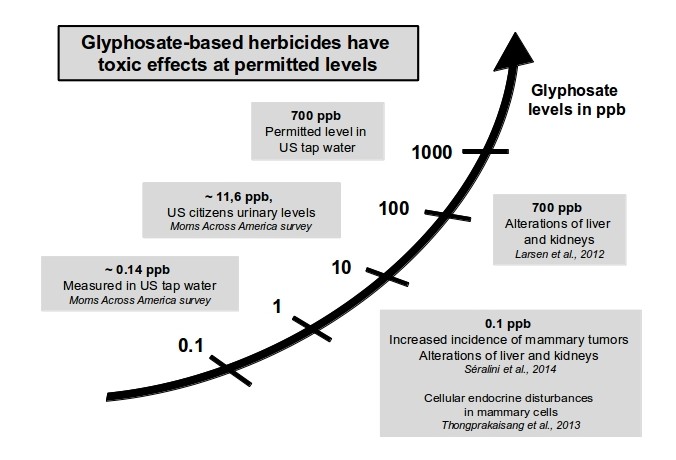Glyphosate in Food & Water
Glyphosate-based formulations are the most widely sold and used pesticides globally. Glyphosate is virtually everywhere in the food chain. As a consequence, glyphosate is regularly detected in human urine. At these levels and even below, several converging lines of research in laboratory animals suggest that glyphosate-based herbicides may be endocrine disruptors and alter liver and kidney function.
Glyphosate-based formulations (the most common being Roundup from Monsanto) are the most widely sold and used pesticides globally. They are used on food crops during cultivation, not only to desiccate the crop before harvest (for instance on wheat), but also more intensively during the cultivation of the 80% of genetically modified organisms (GMOs) that are modified to tolerate Roundup. They are also used in parks, gardens, along roads and railway tracks, and in cemeteries. Since glyphosate’s main mode of action in plants is absent in animals, it is considered to be one of the safest pesticides – even safer than table salt, according to Monsanto. As a consequence, the presence of glyphosate is tolerated at high levels in food and tap water. After more than 30 years of a “don’t look, don’t see” policy on glyphosate’s secondary side effects, many studies in recent years have suggested that glyphosate has worrying health effects at levels regularly detected in food an tap water.
Human contamination and food surveys
Update: Glyphosate has now been found in a range of popular U.S. food products by Anresco Laboratories and also urine of people across America by the University of California San Francisco (UCSF), using validated LC-MS/MS methods.
The cultivation of Roundup Ready GMOs has considerably increased food contamination by glyphosate. Roundup Ready plants do not degrade glyphosate but tolerate it, so they accumulate Roundup residues during their growth. As a consequence, glyphosate has among the highest maximum residue limits for pesticides, with up to 500,000 parts per billion (ppb, see box 1) authorized in some GM feed. A recent study on 10 batches of GM soybeans from Iowa found glyphosate at an average concentration of 11,900 ppb (maximum of 20,100 ppb) [1]. According to Monsanto, residues levels of up to 5,600 ppb in GM soy represent “extreme levels” [2]. Since cattle are mostly fed Roundup Ready soybeans, contamination with extreme levels of glyphosate could have serious consequences on cattle health. In a study on Danish dairy cows [3], elevated glyphosate urinary levels have been linked to a marked increase in biomarkers indicative of damage to liver and kidney function. Another recent study found glyphosate in the organs of piglets born with birth defects [4]. In this case, the highest concentrations were measured in lungs (0.4-80 ppb), heart (0.15-80 ppb), and kidneys (0.1-38 ppb). This strongly suggests bioaccumulation of glyphosate in internal organs, which is contrary to the common belief of rapid elimination.
Test Your Food and Water for Glyphosate @ Home Here Using the First Ever Glyphosate Strip Tests
Permitted levels in tap water reach 700 ppb in USA, which is particularly high for a pesticide. Among 85 tap water samples analyzed by Moms Across America and Sustainable Pulse [5], glyphosate was found in 35 cases at levels up to 0.3 ppb. Glyphosate contamination in food appears common. UK government testing for glyphosate residues in bread showed frequent glyphosate contamination, sometimes exceeding 500 ppb in wholemeal bread [6]. The global contamination is certainly underestimated. Analysis of 69 honey samples from different origins revealed glyphosate at unexpectedly high levels, around 64 ppb [7]. Some samples were contaminated with 163 ppb, a concentration neurotoxic to honeybees. A recent analysis even documented the presence of glyphosate in Froot Loops at a level of 120 ppb [8].

Glyphosate is present at all levels of the food chain: in water, plants, animals, and even in humans. Every single study that has measured human contamination with glyphosate has found it. The most recent survey [5], performed by Moms Across America and Sustainable Pulse, measured glyphosate levels in the urine of 85 US citizens: 17 were recruited in the streets of Washington DC; the others, volunteers among the members of Moms Across America, were spread across the country. Glyphosate was detected in 22 cases at an average concentration of 12.6 ppb. The maximum of 18.8 ppb was measured in the urine of a woman in Oregon. Comparable levels have been detected in a survey performed on farming and non-farming families in Iowa [9]. Glyphosate was detected in the majority of samples, including more than 95% of the children’s urine samples (maximum of 18 ppb). In Europe, a survey by Friends of the Earth across 18 countries found glyphosate in 80 out of 182 urinary samples taken from volunteers [6]. Another European survey by Monika Kruger showed average urinary glyphosate levels of 5.4 ppb (maximum of 40 ppb) [10]. In this study, chronically ill humans had higher glyphosate residues in urine than healthy humans.

Toxic effects of glyphosate and its commercial formulations
Despite claims that glyphosate has been widely studied by regulatory agencies and industry, little is known about the health effects of glyphosate-based herbicides at levels found in food or water. Indeed, to estimate a safe level of glyphosate for regulatory purposes, glyphosate has been tested in long-term and developmental toxicity tests in rodents. All these tests have been performed with glyphosate alone at very high levels. However, the exposure of animals at doses ranging from around 10,000 ppb during their whole life is not relevant to conclude on the effects of exposures in the much lower dose range of 10-100 ppb. Many pesticides are endocrine disruptors, meaning that they disrupt cell communications and exercise their toxic effects at low doses over long periods of time – even when higher doses do not have these effects. Various studies have found that glyphosate and Roundup can be endocrine disruptors at levels permitted in tap water [11,12].
The only long-term study at environmentally relevant concentrations was performed with 0.1 ppb of Roundup diluted in drinking water of rats [11]. The incidence of mammary tumors significantly increased in this study. Out of 10 rats treated with Roundup at 0.1 ppb, 9 developed 20 mammary tumors, whereas 5 out of 10 controls only developed 8 tumors. Hormones (Testosterone and estradiol) serum levels were also altered. These results are corroborated by cellular endocrine disturbances found in human mammary cells [12]. Glyphosate was able to replace estrogen and to promote the growth of human mammary cells at around 0.1 ppb. In another study at higher doses, a maternal exposure to a glyphosate-based herbicide during pregnancy was able to disrupt rat pup development [13]. In the above-cited cases, as for other endocrine disruptors, toxic effects do not always increase in proportion to the dose. In these cases, and contrary to the common industry claim, the dose does not make the poison. These effects are thus not likely to be detected in regulatory tests using only high levels of glyphosate, as has happened in the past for the plastics chemical bisphenol A and other endocrine disruptors [14].
Converging lines of evidence have demonstrated that Roundup residues pose a risk to the kidneys and the liver. In the study performed by Professor Gilles-Eric Séralini, rats treated with 0.1 ppb of Roundup presented an increased rate of severe chronic kidney disease [11]. This may also explain observed increases in the frequency of chronic kidney disease among farmers [15]. The liver was also affected; rats treated with 0.1 ppb Roundup presented more liver abnormalities such as congestion or necrotic (dead) areas [11]. In another study [16], Wistar rats were exposed during 30 or 90 days to the highest level (700 ppb) of glyphosate allowed in water for human consumption in USA. While no tissue changes were detected in the study, changes in the biochemistry indicated stress at the level of the kidneys and the liver. All these effects are detected well below regulatory thresholds, in a range of concentrations corresponding to potential human exposures to glyphosate-based herbicide residues.

In conclusion, several converging lines of evidence suggest worrying effects of glyphosate at levels detected in food, water, and even in human bodies. The toxicity tests performed in glyphosate regulatory assessments were unable to detect these effects, because they were performed with too high doses, and did not take into account recent scientific knowledge about toxicology.
Understanding the ppb unit.
1 part per billion (ppb) is equivalent to 1 µg/kg or 1 µg/L of a given substance. It represents the concentration of a molecule or a mixture. For a mixture, 1 ppb corresponds to a dilution of 1 billion.
1 ppb of Roundup represents the dilution of a teaspoon of Roundup in the volume of an Olympic swimming pool. 700 µg of glyphosate dissolved in one litre of water corresponds to a concentration of 700 ppb, the level admitted in US tap water. It corresponds to one drop of Roundup in 25 litres of tap water.
Commercial formulations of glyphosate contain other toxicants.
Glyphosate is never used alone, but in commercial formulations containing additional toxic agents called adjuvants. They are used to increase glyphosate’s toxicity and to allow its penetration into plants. They are in some cases more toxic than glyphosate [17], but they are never included in glyphosate long-term toxicity tests and are considered to be inert, like water. They constitute a “black hole” in pesticide toxicology, because they are often kept secret by companies, are never measured in the environment, and are not included in the establishment of pesticide acceptable daily intakes.
References
- Bohn T, et al. (2014) Compositional differences in soybeans on the market: glyphosate accumulates in Roundup Ready GM soybeans. Food Chem 153: 207-215.
- Independent Science News (2014) How “Extreme Levels” of Roundup in Food Became the Industry Norm. www.independentsciencenews.org/news/how-extreme-levels-of-roundup-in-food-became-the-industry-norm/
- Krüger M, et al. (2013) Field Investigations of Glyphosate in Urine of Danish Dairy Cows. J Environ Anal Toxicol 3: 186.
- Krüger M, et al. (2014) Detection of Glyphosate in Malformed Piglets. J Environ Anal Toxicol 4: 230.
- Moms Across America (2014) Glyphosate Testing Full Report: Findings in American Mothers’ Breast Milk, Urine and Water. http://www.momsacrossamerica.com/glyphosate_testing_results
- Friends of the Earth Europe (2013) Human contamination by glyphosate. http://www.foeeurope.org/sites/default/files/press_releases/foee_4_human_contamination_glyphosate.pdf
- Rubio F, Kamp L , (2014) Survey of Glyphosate Residues in Honey, Corn and Soy Products. J Environ Anal Toxicol 4: 249.
- GMO Free USA (2015) Kellogg’s Froot Loops Tests Positive For GMOs and Weedkiller. http://www.gmofreeusa.org/food-testing/kelloggs/kelloggs-froot-loops/
- Curwin BD, et al. (2007) Urinary pesticide concentrations among children, mothers and fathers living in farm and non-farm households in iowa. Ann Occup Hyg 51: 53-65.
- Krüger M., et al. (2014) Detection of Glyphosate Residues in Animals and Humans. J Environ Anal Toxicol 4: 210.
- Seralini G-E, et al. (2014) Republished study: long-term toxicity of a Roundup herbicide and a Roundup-tolerant genetically modified maize. Environmental Sciences Europe 26: 14.
- Thongprakaisang S, et al. (2013) Glyphosate induces human breast cancer cells growth via estrogen receptors. Food Chem Toxicol 59C: 129-136.
- Romano M, et al. (2012) Glyphosate impairs male offspring reproductive development by disrupting gonadotropin expression. Arch Toxicol 86: 663 – 673.
- Vandenberg LN, et al. (2012) Hormones and endocrine-disrupting chemicals: low-dose effects and nonmonotonic dose responses. Endocr Rev 33: 378-455.
- Jayasumana C, et al. (2015) Drinking well water and occupational exposure to Herbicides is associated with chronic kidney disease, in Padavi-Sripura, Sri Lanka. Environ Health 14: 6.
- Larsen K, et al. (2012) Effects of sub-lethal exposure of rats to the herbicide glyphosate in drinking water: glutathione transferase enzyme activities, levels of reduced glutathione and lipid peroxidation in liver, kidneys and small intestine. Environ Toxicol Pharmacol 34: 811-818.
- Mesnage R, et al. (2013) Ethoxylated adjuvants of glyphosate-based herbicides are active principles of human cell toxicity. Toxicology 313: 122 – 128. 13.
- Acquavella JF, et al. (2004) Glyphosate biomonitoring for farmers and their families: results from the Farm Family Exposure Study. Environ Health Perspect. Mar;112(3):321-6.
- Mesnage R, et al. (2012) Glyphosate Exposure in a Farmer’s Family. Journal of Environmental Protection 3:1001-1003.
Disclaimer: The Detox Project does not provide medical advice or diagnostics, so the information on this site is not in any way suggesting that eating an organic diet will certainly lower the level of glyphosate in your body, nor is The Detox Project suggesting that any health condition you may have will improve if you manage to lower the glyphosate level in your body.